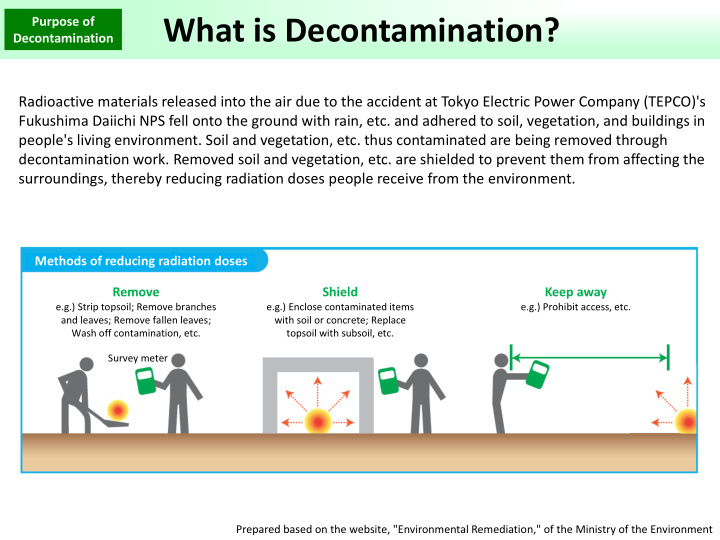



What is Decontamination? Purpose of Decontamination Radioactive materials released into the air due to the accident at Tokyo Electric Power Company (TEPCO)'s Fukushima Daiichi NPS fell onto the ground with rain, etc. and adhered to soil, vegetation, and buildings in people's living environment. Soil and vegetation, etc. thus contaminated are being removed through decontamination work. Removed soil and vegetation, etc. are shielded to prevent them from affecting the surroundings, thereby reducing radiation doses people receive from the environment. Methods of reducing radiation doses Remove Shield Keep away e.g.) Strip topsoil; Remove branches e.g.) Enclose contaminated items e.g.) Prohibit access, etc. and leaves; Remove fallen leaves; with soil or concrete; Replace Wash off contamination, etc. topsoil with subsoil, etc. Survey meter Prepared based on the website, "Environmental Remediation," of the Ministry of the Environment
Decontamination Decontamination and Decreases in Radiation Purpose of Doses Decreases in doses of accident‐derived radioactive materials Radiation dose Before decontamination Decontamination work After decontamination Time Compared with the level as of Aug. 2011, radiation doses naturally decreased by approx. 40% in two years and by approx. 60% in five years. Additionally, radiation doses can be reduced faster by removing radioactive materials through decontamination work. Prepared based on the website, "Environmental Remediation," of the Ministry of the Environment
Purpose of Decontamination Methods Decontamination Decontamination has been conducted in accordance with the circumstances of respective areas. Specific methods differ by location. Effective methods differ depending on the status of contamination with radioactive materials. First, ambient dose rates are measured, and an optimal method is selected on a case‐by‐case basis. Radiation doses are measured before and after decontamination work to confirm the effects. Selection of Confirmation Decontamination Measurement decontamination work of the effects methods 除染 Decontamination methods employed in areas with relatively low radiation doses The following are examples. Case 事例 1 1 Removal of sludge from ditches Cleaning of eaves and gutters of private houses Mowing of vegetation (Provided by Date City) (Provided by Fukushima City) Decontamination methods employed in areas with relatively high radiation doses (in addition to the above methods) 除染 Case 事例 2 2 Scraping off of topsoil of school yards Washing of building roofs, etc. Scraping off of garden soil, etc. (Provided by JAEA) (Provided by Date City) Prepared based on the website, "Environmental Remediation," of the Ministry of the Environment
Decontamination Special Decontamination Areas and Intensive Contamination Survey Areas In line with the Act on Special Measures Concerning the Handling of Environment Pollution by Radioactive Materials enforced in full on January 1, 2012, and the Basic Policy based thereon, decontamination has been carried out. Areas especially necessary from the perspective of protecting human health were prioritized. Soil, etc. removed through decontamination work is collected, transported to Temporary Storage Sites, and disposed of safely. Special Decontamination Areas ○ Areas where the national government directly conducts decontamination work; Basically, 11 municipalities* in Fukushima Prefecture which were once designated as a Restricted Area or a Deliberate Evacuation Area are designated. ○ A decontamination plan should be formulated for each Special Decontamination Area, while taking into account respective municipalities' needs, and decontamination should be conducted in line with the plan. * The entire areas of Naraha Town, Tomioka Town, Okuma Town, Futaba Town, Namie Town, Katsurao Village and Iitate Village, and parts of Tamura City, Minamisoma City, Kawamata Town and Kawauchi Village which were once designated as a Restricted Area or a Deliberate Evacuation Area Intensive Contamination Survey Areas ○ Areas where municipalities take the initiative in decontamination work; 92 municipalities in eight prefectures* are designated as Intensive Contamination Survey Areas (as of the end of December 2017) from among municipalities including areas where measured ambient dose rates were 0.23 μSv/h or higher. ○ Each municipality should carry out a measurement and survey, formulate a decontamination plan based on the results thereof, and conduct decontamination in line with the plan. ○ The national government takes financial measures and technical measures to assist these municipalities. * Iwate Prefecture, Miyagi Prefecture, Fukushima Prefecture, Ibaraki Prefecture, Tochigi Prefecture, Gunma Prefecture, Saitama Prefecture and Chiba Prefecture Prepared based on the website, "Environmental Remediation," of the Ministry of the Environment"
Decontamination Progress of Decontamination Work Special Decontamination Areas Intensive Contamination Survey Areas Municipalities for which the designation as an Iwate Intensive Contamination Survey Area has been lifted Prefecture Municipalities where whole area decontamination work has been completed Iitate Municipalities where whole area decontamination work is underway Village Kawamata Special Decontamination Areas Town Miyagi Minamisoma Prefecture City Katsurao Village Namie Fukushima Prefecture Town Futaba TEPCO's Town Fukushima Tamura Daiichi Nuclear City Power Okuma Town Station Tochigi Prefecture Gunma Prefecture Tomioka Evacuation Orders‐Lifted Areas Ibaraki Prefecture Town Kawauchi Whole‐Area‐Decontamination Village Saitama ‐Completed Areas Prefecture Naraha Special Decontamination Areas Town Chiba Areas where Returning Prefecture is Difficult As of April 1, 2017 As of the end of December 2017 Prepared based on the website, "Environmental Remediation," of the Ministry of the Environment
Storage in Temporary Storage Sites Storage of (When Storing Removed Soil above Ground) Removed Soil, etc. Soil removed through decontamination work is stored safely on site or at Temporary Storage Sites for a certain period of time. In case of storing removed soil above ground (in such cases as where the groundwater level is high) Embankment sufficient Safe distance for shielding Impermeable layer Flexible containers (filled with removed soil ) Survey meter Sandbags Barrier Barrier Protective layer (to assist Impermeable sheet Water drain pipe Rainwater water collection) drain ditch Monitoring of radioactive Water collecting tank materials in groundwater (for checking radioactive materials) Groundwater level Prepared based on the website, "Environmental Remediation," of the Ministry of the Environment
Recommend
More recommend